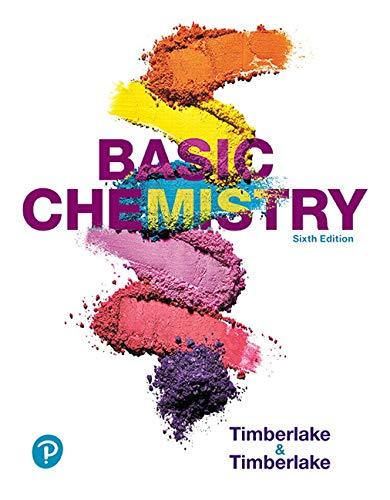
(a)
Interpretation: The equilibrium expression for the following reaction should be determined:
Concept Introduction:
The relationship between the concentration of products and reactants at equilibrium for a general reaction:
Where A, B, C, and D represents chemical species and a, b, c, and d are the coefficients for balanced reaction.
The equilibrium expression, Kc for reversible reaction is determined by multiplying the concentrations of products together and divided by the concentrations of the reactants. Each concentration is raised to the power that is equal to the coefficient in the balanced reaction. So, the expression is:
Square brackets represent the concentration.
(b)
Interpretation: The equilibrium expression for the following reaction should be determined:
Concept Introduction:
The relationship between the concentration of products and reactants at equilibrium for a general reaction:
Where A, B, C, and D represents chemical species and a, b, c, and d are the coefficients for balanced reaction.
The equilibrium expression, Kc for reversible reaction is determined by multiplying the concentrations of products together and divided by the concentrations of the reactants. Each concentration is raised to the power that is equal to the coefficient in the balanced reaction. So, the expression is:
Square brackets represent the concentration.
(c)
Interpretation: The equilibrium expression for the following reaction should be determined:
Concept Introduction:
The relationship between the concentration of products and reactants at equilibrium for a general reaction:
Where A, B, C, and D represents chemical species and a, b, c, and d are the coefficients for balanced reaction.
The equilibrium expression, Kc for reversible reaction is determined by multiplying the concentrations of products together and divided by the concentrations of the reactants. Each concentration is raised to the power that is equal to the coefficient in the balanced reaction. So, the expression is:
Square brackets represent the concentration.
(d)
Interpretation: The equilibrium expression for the following reaction should be determined:
Concept Introduction:
The relationship between the concentration of products and reactants at equilibrium for a general reaction:
Where A, B, C, and D represents chemical species and a, b, c, and d are the coefficients for balanced reaction.
The equilibrium expression, Kc for reversible reaction is determined by multiplying the concentrations of products together and divided by the concentrations of the reactants. Each concentration is raised to the power that is equal to the coefficient in the balanced reaction. So, the expression is:
Square brackets represent the concentration.
Want to see the full answer?
Check out a sample textbook solution
Chapter 13 Solutions
Basic Chemistry Plus Mastering Chemistry With Pearson Etext -- Access Card Package (6th Edition)
- Construct a molecular orbital energy-level diagram for BeH2. Sketch the MO pictures (schematic representation) for the HOMO and LUMO of BeH2 [Orbital Potential Energies, H (1s): -13.6 eV; Be (2s): -9.3 eV, Be (2p): -6.0 eV]arrow_forwardIndicate the isomers of the A(H2O)6Cl3 complex. State the type of isomerism they exhibit and explain it briefly.arrow_forwardState the formula of the compound potassium μ-dihydroxydicobaltate (III) tetraoxalate.arrow_forward
- Consider the reaction of the cyclopentanone derivative shown below. i) NaOCH2CH3 CH3CH2OH, 25°C ii) CH3!arrow_forwardWhat constitutes a 'reference material', and why does its utilization play a critical role in the chemical analysis of food products? Provide examples.arrow_forwardExplain what calibration is and why it is essential in relation to food analysis. Provide examples.arrow_forward
- The cobalt mu-hydroxide complex cobaltate(III) of potassium is a dinuclear complex. Correct?arrow_forwardThe cobalt mi-hydroxide complex cobaltate(III) of potassium is a dinuclear complex. Correct?arrow_forward3. Arrange the different acids in Exercise B # 2 from the strongest (1) to the weakest acid (10). 1. 2. (strongest) 3. 4. 5. 6. 7. 8. 9. 10 10. (weakest)arrow_forward
- Name Section Score Date EXERCISE B pH, pOH, pка, AND PKD CALCULATIONS 1. Complete the following table. Solution [H+] [OH-] PH РОН Nature of Solution A 2 x 10-8 M B 1 x 10-7 M C D 12.3 6.8 2. The following table contains the names, formulas, ka or pka for some common acids. Fill in the blanks in the table. (17 Points) Acid Name Formula Dissociation reaction Ka pka Phosphoric acid H₂PO₁ H3PO4 H++ H₂PO 7.08 x 10-3 Dihydrogen H₂PO H₂PO H+ HPO 6.31 x 10-6 phosphate Hydrogen HPO₁ 12.4 phosphate Carbonic acid H2CO3 Hydrogen HCO 6.35 10.3 carbonate or bicarbonate Acetic acid CH,COOH 4.76 Lactic acid CH₂CHOH- COOH 1.38 x 10 Ammonium NH 5.63 x 10-10 Phenol CH₂OH 1 x 10-10 Protonated form CH3NH3* 3.16 x 10-11 of methylaminearrow_forwardIndicate whether it is true that Co(III) complexes are very stable.arrow_forwardMnO2 acts as an oxidant in the chlorine synthesis reaction.arrow_forward
 General, Organic, and Biological ChemistryChemistryISBN:9781285853918Author:H. Stephen StokerPublisher:Cengage Learning
General, Organic, and Biological ChemistryChemistryISBN:9781285853918Author:H. Stephen StokerPublisher:Cengage Learning World of Chemistry, 3rd editionChemistryISBN:9781133109655Author:Steven S. Zumdahl, Susan L. Zumdahl, Donald J. DeCostePublisher:Brooks / Cole / Cengage Learning
World of Chemistry, 3rd editionChemistryISBN:9781133109655Author:Steven S. Zumdahl, Susan L. Zumdahl, Donald J. DeCostePublisher:Brooks / Cole / Cengage Learning Principles of Modern ChemistryChemistryISBN:9781305079113Author:David W. Oxtoby, H. Pat Gillis, Laurie J. ButlerPublisher:Cengage Learning
Principles of Modern ChemistryChemistryISBN:9781305079113Author:David W. Oxtoby, H. Pat Gillis, Laurie J. ButlerPublisher:Cengage Learning Chemistry for Today: General, Organic, and Bioche...ChemistryISBN:9781305960060Author:Spencer L. Seager, Michael R. Slabaugh, Maren S. HansenPublisher:Cengage Learning
Chemistry for Today: General, Organic, and Bioche...ChemistryISBN:9781305960060Author:Spencer L. Seager, Michael R. Slabaugh, Maren S. HansenPublisher:Cengage Learning Chemistry: The Molecular ScienceChemistryISBN:9781285199047Author:John W. Moore, Conrad L. StanitskiPublisher:Cengage Learning
Chemistry: The Molecular ScienceChemistryISBN:9781285199047Author:John W. Moore, Conrad L. StanitskiPublisher:Cengage Learning





